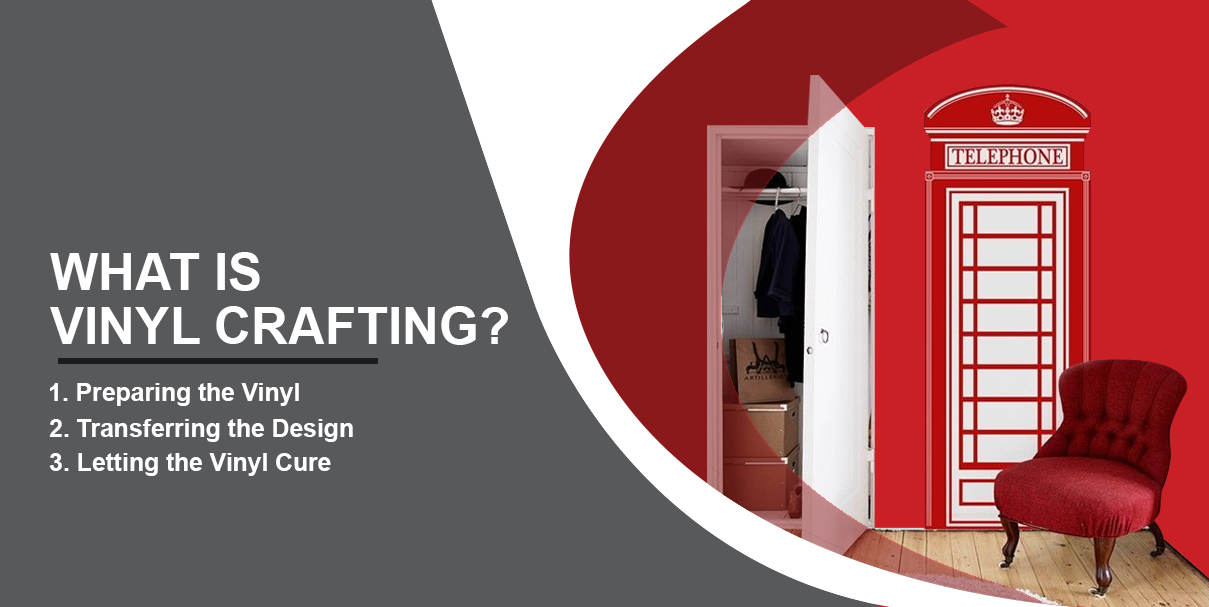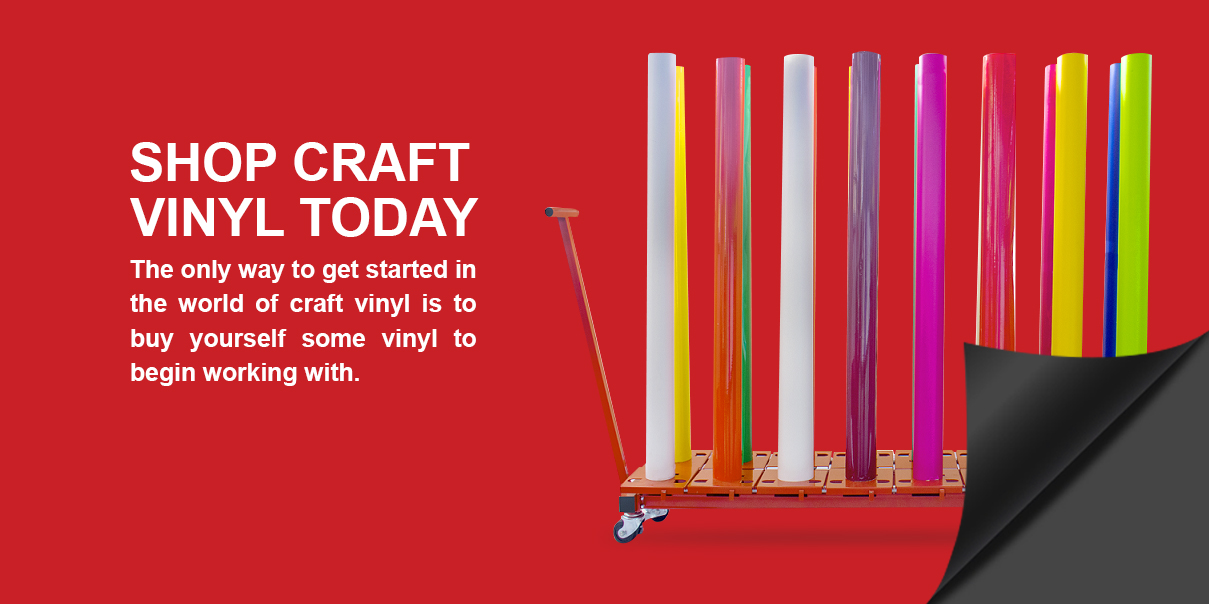
Vinyl Crafting 101
Are you a crafter extraordinaire? Do you relish creating new projects, working with new materials and learning how to use new supplies? If so, you've probably mastered plenty of crafting staples. Maybe you’re frequently experimenting with new ways to personalize your possessions and make them a little more unique. You're probably always on the lookout for exciting new materials to work with.
If so, we’d like to introduce you to the world of vinyl work. Vinyl may not be the newest or flashiest material on the block, and you may not have given it much consideration, especially when it comes to crafting. When many of us think of vinyl, we probably think of it regarding clothing, shoes, flooring or perhaps even as a type of record. Quite possibly, you’ve never considered all the different purposes it could have when it comes to crafting and living a more colorful and creative life.
Today, we want to walk you through just a few of the basics and potential applications of one of the most versatile and unique materials in your arsenal — vinyl. We’ve built this comprehensive guide to keep things simple and serve as an introduction to the topic. For all your vinyl questions and concerns, this is the place to be.

What Is Vinyl Crafting?
While vinyl can refer to a great many different things in many different industries, it has a particular definition in the world of artistic design. Regarding arts and crafts, vinyl can create a design on a temporary surface before transferring this same design to a more permanent surface. For example, think of iron-on T-shirt decals. These are an excellent example of how you can use vinyl in crafting. It’s just one use, however, and there is a whole world of other projects you can do in addition to this simple one. Car decals are another great example, as are personalized greeting cards.
Crafting with vinyl typically involves several distinct steps. Keep in mind that although we've highly simplified and streamlined these steps here, they take much longer in practice and can include lots of different sub-steps.
1. Preparing the Vinyl
During this stage, you’ll do all your preparations. You’ll purchase the supplies you need, and you’ll begin to conceptualize your design. You’ll draw sketches and finesse the design until you feel confident and ready to move onto the real thing. At this point, you’ll cut your vinyl into the shape of your design, adding finishing touches and flourishes until it looks just the way you want.
2. Transferring the Design
Once you've perfected your design by shaping and molding it out of vinyl, it’s time to transfer it onto your permanent surface. This step can happen in several different ways, depending on the type of vinyl you’re using, and we’ll talk more about that later. For now, it’s just important to know that in this stage, your vinyl firmly and securely adheres to its new home.
3. Letting the Vinyl Cure
Most vinyl has adhesive properties that help it stick to its new surface, but this doesn’t happen immediately. In many cases, these glues need time to adapt to their new surface and to harden into place. While it depends on what you’re working on, a good benchmark is 72 hours for a curing process. After this, your vinyl design should be very secure and not in danger of rubbing off.
Different Types of Vinyl
As we mentioned before, vinyl is a very versatile tool, meaning it comes in a lot of different forms and can apply to a variety of situations. Overall, vinyl comes in two basic forms. Let’s look at both of those now.
1. Adhesive Vinyl
Stickers are a kind of adhesive vinyl craft film and are probably the version of this material we’re most familiar with in our everyday life. These pieces of vinyl have a self-adhesive back that’s ready to stick onto certain types of materials without any extra work on your part. These thin, flexible sheets of vinyl have a pressure-sensitive adhesive backing. The adhesive doesn't usually activate until you firmly press the vinyl against a material.
In other words, this is the type of vinyl you can peel off its protective sheet and stick onto a new surface. For many reasons, this keeps things simple and straightforward.
2. Heat-Transfer Vinyl
This type of vinyl is slightly more complex and only adheres when you apply heat. It uses a similar material — thin, flexible and pliable — but it it’s heat-activated instead of pressure-activated. This type of vinyl works well on fabric, or on any other surface that can stand up to the necessary heat to make the vinyl stick.
What Are Some Tools to Use With Your Vinyl Crafting?
As every crafter knows, you can’t accomplish anything without the right tools. Sewing requires a needle, thread and scissors. Stamping requires stamps, ink and different papers. In the same way, vinyl work requires a unique set of tools to help you get exactly the results you’re looking for.
In no particular order, here are a few of the tools you may want to think about collecting if you plan on completing a vinyl project sometime in the future.
- Electronic cutting machine: This type of machine is exactly what it sounds like. It helps you cut vinyl into all kinds of different shapes and sizes, and makes the process far easier and more streamlined than if you were to attempt it by hand. Unlike a simple sewing machine or something else that’s hand-operated, this is an electronic machine that operates according to computer prompts.
- Software: There are lots of different versions of cutting machine software that will allow you to interact with your cutting machine and give it instructions to cut out your design in precisely the shape you want as a result.
- Blades: As excellent as cutting machines are, you will need to replace their blades regularly. Make sure to shop for blades that are compatible with your specific cutting machine, or else you’ll be in for a disappointment when you try to attach them.
- Cutting mats: You don’t want to get so carried away in your cutting, sticking and pinning that you accidentally cut directly through your tablecloth or whatever else you have down over your work area. To prevent this, invest in a cutting mat that will protect all your everyday surfaces from your cutting madness.
- Weeding hook: Weeding is a process that lets you remove all the little pieces of vinyl that aren’t part of your design, but that a cutting machine might not quite have caught. A weeding hook is a tool that lets you do this — it’s a fine-tipped little hook that looks similar to something the dentist might use during your regular cleaning.
- Transfer tape: Moving your vinyl away from its original backing and transferring it to its new home? You’ll want transfer tape to help you keep all the pieces together for this transition phase.
- Application tool: This is a tool that helps you apply your vinyl decal with precise, even movements. You can also do this with your hand or even a credit card, but this tool helps ensure the best and most even outcome.
- Masking tape: This heavy-duty tape is excellent for positioning your vinyl while you’re still trying to arrange it and aren’t committed to pressing it down yet.
- Iron or heat press: For those heat-activated vinyl decals, an iron is a must-have tool. It will help your heat clings stick to their new surface and, in some cases, will literally iron them into place.
- Parchment paper: Anytime you plan to apply heat, you’ll want to have this type of paper down as a protective layer over your surface, so you don’t accidentally damage your table or counter.

What Can You Make With Your Vinyl Crafts?
Alright, so we now know a little bit more about what vinyl is, how to cut and manipulate it, and what tools craftspeople use to make their projects a reality. But what kinds of things can you make with vinyl, anyway? While it would be impossible to mention everything you could make, here are a few of the common ones.
- T-shirts: It’s most likely you will create these through heat-transfer vinyl. Work up a cool design on your computer, cut it out with your cutting machine and iron it onto a T-shirt for a one-of-a-kind design you won't find in any store.
- Stickers and labels: Have you ever wanted to design stickers for decorating your laptop, bathroom mirror or day planner? With vinyl crafting techniques, you can do just that. You can also make handy labels for different things around your home or office.
- Car wraps: Sometimes, your car needs a little extra decoration. With a good vinyl cutting machine, you can design whatever shape, logo or pattern you want before cutting it out and sticking it onto your car’s exterior. These types of vinyl will likely be the self-sticking varieties instead of the heat-transfer kind.
- Signage: There are plenty of occasions where you might need a little signage work. Maybe you'll make tiny signs to label appetizers at a party, or a massive banner for a wedding. Whatever you’ve got in mind, we think vinyl is the perfect way to create this sort of signage.
- Cards: A vinyl decoration can sometimes be just the touch that makes a homemade card that much more special and beautiful. Because the cards are typically paper or cardstock, you will also usually use press-on vinyl.
- And many more: There is virtually no end to all the different ways you can incorporate vinyl into your projects. You can decorate or enhance almost any object with vinyl, from your coasters to your coffee mugs, and from your laptop to your phone. All it takes is a little imagination to begin seeing the possibilities.
How to Get Started With Vinyl Crafting
There’s no right or wrong way to get started with any new type of crafting, and vinyl work is no different. You can start anytime, with any amount of supplies and with any project. However, if you’re looking for a few specific tips to help get you on track, you can’t go wrong by following these basic steps.

1. Gather Some Materials
You can’t start vinyl work until you have rounded up a few essential materials. Obviously, the most important resource you’ll need is the vinyl itself. Remember, there are two types of vinyl to choose from, and each is appropriate for different types of work. As you’re just starting out, we recommend getting some of both types of vinyl and experimenting. Try a few sample projects, and don’t worry about making anything perfect. Instead, just focus on getting a feel for how the vinyl works and how you can manipulate it.
You may want to start out with a cutting machine and accompanying software, or you may want to begin with a pair of scissors. It’s entirely up to you. A cutting machine makes the process easier and also makes it possible to achieve more complex designs, but you may also be interested in experimenting with scissors as you start to get a feel for vinyl as a crafting element.
2. Do Some Research
There are plenty of great resources out there with additional tips on how to work with vinyl. Your local library or bookstore will have books you can read, and the Internet is overflowing with resources for you to take advantage of — everything from patterns to ideas to tips and tricks, all of which you can try out for yourself as you begin to be more comfortable in this new medium.
3. Make Some Connections
Everything is more fun when you do it in a group. Explore the Internet for forums and discussion groups where other people just like you are chatting about their latest vinyl projects. Ask your friends and family if they’ve ever tried working with vinyl, and share your knowledge with them. The more people you have to connect with and talk to, the more fun this hobby can be.

Shop Craft Vinyl Today
The only way to get started in the world of craft vinyl is to buy yourself some vinyl to begin working with. While you can buy certain types of vinyl at your local craft store, you'll want to purchase more specialized types of vinyl from other locations. If you plan on creating some striking vinyl decorations for your car, for example, you’ll want to get that vinyl from a dedicated shop.
For your next car vinyl, browse our selection of craft vinyl here at Rvinyl. We offer a range of different patterns, colors and styles to choose from, so no matter what design you’re thinking of making, you’ll be able to find just the vinyl for it here. If you have any additional questions or concerns, please don’t hesitate to contact us.